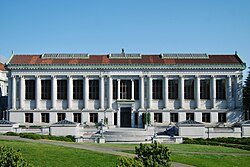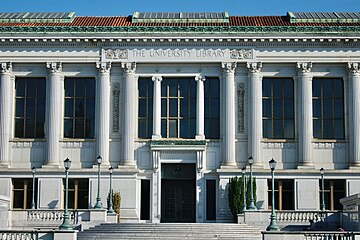
Arthur Brown Jr. (1874–1957) was an American architect, based in San Francisco and designer of many of its landmarks. He is known for his work with John Bakewell Jr. as Bakewell and Brown, along with later works after the partnership dissolved in 1927.

Sterling Memorial Library (SML) is the main library building of the Yale University Library system in New Haven, Connecticut, United States. Opened in 1931, the library was designed by James Gamble Rogers as the centerpiece of Yale's Gothic Revival campus. The library's tower has sixteen levels of bookstacks containing over 4 million volumes. Several special collections—including the university's Manuscripts & Archives—are also housed in the building. It connects via tunnel to the underground Bass Library, which holds an additional 150,000 volumes.

The Bancroft Library is the primary special-collections library of the University of California, Berkeley. It was acquired from its founder, Hubert Howe Bancroft, in 1905, with the proviso that it retain the name Bancroft Library in perpetuity. The collection at that time consisted of 50,000 volumes of materials on the history of California and western North America. It is now the largest such collection in the world. The library's current building, the Doe Annex, is in the center of the university's main campus, and was completed in 1950.
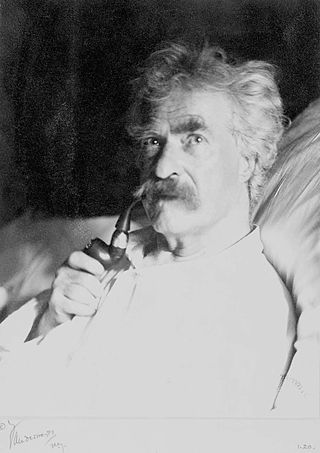
The Autobiography of Mark Twain is a written collection of reminiscences, the majority of which were dictated during the last few years of the life of American author Mark Twain (1835–1910) and left in typescript and manuscript at his death. The Autobiography comprises a collection of anecdotes and ruminations rather than a conventional autobiography. Twain never compiled the writings and dictations into a publishable form in his lifetime. Despite indications from Twain that he did not want his autobiography to be published for a century, he serialized selected chapters during his lifetime; in addition, various compilations were published during the 20th century. However, it was not until 2010 that the first volume of a comprehensive three-volume collection, compiled and edited by The Mark Twain Project of the Bancroft Library at University of California, Berkeley, was published.
The University of California operates the largest academic library system in the world. It manages more than 40.8 million print volumes in 100 libraries on ten campuses. The purpose of these libraries is to assist research and instruction on the University of California campuses. While each campus library is separate, they share facilities for storage, computerized indexing, digital libraries and management.

Blake Garden is a teaching facility for the UC Berkeley College of Environmental Design in the hills of Kensington, California, a census-designated place of the East Bay region of the Bay Area in Northern California, approximately 4 mi (6.4 km) north of the main University of California, Berkeley campus. It was originally designed by landscape architect Mabel Symmes for the estate owned by her sister and brother-in-law, Anita and Anson Blake; the trio lived in Blake House, a mansion on the estate designed by architect Walter Danforth Bliss and completed in 1924. The Blakes deeded the grounds to their alma mater, the University of California, in 1957, which took full control after Anita's death in 1962, implementing a redesign by Geraldine Knight Scott starting from 1964. Blake House served as the official residence of the President of the University of California from 1967 to 2008. Since 2009, Blake Garden has been open to the public on weekdays.

The University of California, Berkeley, School of Information, also known as the UC Berkeley School of Information or the I School, is a graduate school and, created in 1994, the newest of the schools at the University of California, Berkeley. It was previously known as the School of Information Management and Systems (SIMS) until 2006. Its roots trace back to a program initiated in 1918 which became the School of Librarianship in 1926 and, with a broader scope, the School of Library and Information Studies in 1976. The program is located in the South Hall, near Sather Tower in the center of the campus.

Evans Hall is the statistics, economics, and mathematics building on the campus of the University of California, Berkeley.
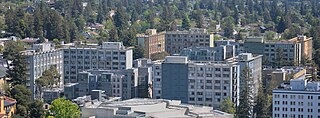
Housing at the University of California, Berkeley, includes student housing facilities run by the office of Residential and Student Service Programs (RSSP). Housing is also offered by off-campus entities such as fraternities and sororities and the Berkeley Student Cooperative (BSC).

Eaton Hall, built in 1908 as Eaton Memorial Library, used to be the main library building at Tufts University in Medford, Massachusetts. The historic building was designed by Whitfield & King and donated to the university by Andrew Carnegie. It was one of the first college libraries built with Carnegie funds and is one of the few that never bore his name. Today the building houses departmental offices, classrooms and a computer lab.

Thirty-one constituent and affiliated libraries combine to make the library system of the University of California, Berkeley the sixth largest research library by number of volumes in the United States.
The campus of the University of California, Berkeley, and its surrounding community are home to a number of notable buildings by early 20th-century campus architect John Galen Howard, his peer Bernard Maybeck, and their colleague Julia Morgan. Subsequent tenures as supervising architect held by George W. Kelham and Arthur Brown, Jr. saw the addition of several buildings in neoclassical and other revival styles, while the building boom after World War II introduced modernist buildings by architects such as Vernon DeMars, Joseph Esherick, John Carl Warnecke, Gardner Dailey, Anshen & Allen, and Skidmore, Owings and Merrill. Recent decades have seen additions including the postmodernist Haas School of Business by Charles Willard Moore, Soda Hall by Edward Larrabee Barnes, and the East Asian Library by Tod Williams Billie Tsien Architects.

Dwinelle Hall is the second largest building on the campus of the University of California, Berkeley. It was completed in 1952, and is named after John W. Dwinelle, the state assemblyman responsible for the Organic Act that established the University of California in 1868 and one of the first Regents of the UC system. Dwinelle houses the departments of classics, rhetoric, linguistics, history, comparative literature, South and Southeast Asian studies, film studies, French, German, Italian studies, Scandinavian, Slavic languages, Spanish and Portuguese, and gender and women's studies.
Edwards Stadium is the track and field and soccer venue for the California Golden Bears, the athletic teams of the University of California, Berkeley. It has been a Berkeley Landmark since November 2, 1992, under the name Edwards Stadium and Field.

H. Morse Stephens was an American historian and professor of history at the University of California, Berkeley who helped to purchase the Bancroft Library, and who worked to build archives of California history, the 1906 San Francisco earthquake, and World War I.
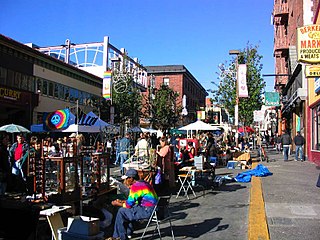
Southside, also known by the older names South of Campus or South Campus, is a neighborhood in Berkeley, California. Southside is located directly south of and adjacent to the University of California, Berkeley campus. Because of the large student presence in the neighborhood, proximity to Sproul Plaza, and history of the area, Southside is the neighborhood most closely associated with the university.
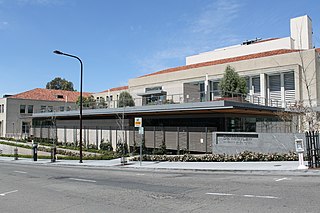
The University of California, Berkeley School of Law is the law school of the University of California, Berkeley. The school was commonly referred to as "Boalt Hall" for many years, although it was never the official name. This came from its initial building, the Boalt Memorial Hall of Law, named for John Henry Boalt. This name was transferred to an entirely new law school building in 1951 but was removed in 2020.

The Free Speech Movement (FSM) was a massive, long-lasting student protest which took place during the 1964–65 academic year on the campus of the University of California, Berkeley. The Movement was informally under the central leadership of Berkeley graduate student Mario Savio. Other student leaders include Jack Weinberg, Michael Rossman, George Barton, Brian Turner, Bettina Aptheker, Steve Weissman, Michael Teal, Art Goldberg, Jackie Goldberg and others.

Etcheverry Hall houses the Departments of Mechanical, Industrial, and Nuclear Engineering of the College of Engineering at the University of California, Berkeley. Etcheverry Hall is named after Bernard A. Etcheverry, professor of irrigation and drainage from 1915 to 1951, who later served as chair of the Department of Irrigation and Drainage from 1923–51. Built in 1964, it is located on the north side of Hearst Avenue, across the street from the main campus.
